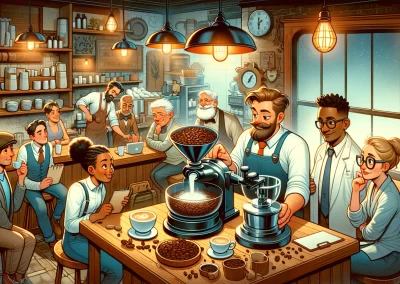The History of Coffee Brewing spans centuries. From the first coffee houses in the Middle East to the modern coffee shops of today, the art of coffee brewing has evolved and developed over time. This history is not only fascinating, but it also sheds light on the cultural significance of coffee and its impact on society.
The history of coffee brewing is intertwined with the cultural and social history of the regions where coffee was first cultivated. As coffee spread from the Middle East to Europe and beyond, it became a symbol of sophistication and refinement. Today, coffee is enjoyed all over the world, and the ways in which it is brewed and consumed vary greatly from country to country. Exploring the history of coffee brewing can provide insights into the cultural and social significance of coffee in different parts of the world.
Origins of Coffee Brewing
Ethiopia
The origin of coffee brewing can be traced back to Ethiopia, where the coffee plant was first discovered in the 9th century. According to legend, a goat herder named Kaldi noticed that his goats became more energetic after eating the berries from a certain tree. He tried the berries himself and found that they gave him a similar boost of energy. This discovery led to the cultivation of coffee plants and the beginning of coffee brewing.
Arabian Peninsula
Coffee brewing then spread to the Arabian Peninsula, where it became a popular drink among Muslims. The first coffee houses, or qahveh khaneh, were established in the 15th century in Mecca and quickly spread throughout the Arab world.
Persia
From the Arabian Peninsula, coffee brewing spread to Persia (modern-day Iran), where coffee was brewed with cardamom and other spices. This spiced coffee, known as qahveh-e-garm, is still popular in Iran today.
Turkey
Coffee brewing then made its way to Turkey, where it became an important part of Turkish culture. Turkish coffee, or Türk kahvesi, is brewed in a special pot called a cezve and is known for its strong flavor and thick, foamy texture.
Europe
Coffee brewing was introduced to Europe in the 16th century, first through trade with the Arabs and later through colonization. Coffee houses began to spring up in major European cities, including London, Paris, and Vienna, and coffee quickly became a popular drink among the upper classes.
British
In the 17th century, the British began to establish coffee plantations in their colonies, including Jamaica and India. This led to the widespread cultivation of coffee around the world and the development of different brewing methods, including drip coffee and espresso.
Overall, the history of coffee brewing is a fascinating one that spans centuries and continents. From its humble beginnings in Ethiopia to its current status as one of the most popular beverages in the world, coffee has played an important role in the history of many cultures.
Early Brewing Techniques
Turkish Coffee
Turkish coffee, also known as “ibrik coffee,” is one of the oldest methods of coffee brewing. It originated in Turkey during the Ottoman Empire and has been enjoyed for centuries. The process involves grinding coffee beans into a fine powder and mixing it with water in an ibrik, a small copper or brass pot. The mixture is then heated on a stove until it reaches a boil. The coffee is served unfiltered, with the grounds settling at the bottom of the cup.
French Press
The French press, also known as a “press pot” or “plunger pot,” was invented in France in the 1850s. It consists of a cylindrical glass or stainless steel container with a plunger and a filter. Coffee grounds are placed in the container, hot water is added, and the mixture is left to steep for several minutes. The plunger is then pressed down, separating the coffee from the grounds.
Coffee Percolator
The coffee percolator was invented in the early 1800s and was a popular method of brewing coffee until the 1970s. It consists of a pot with a chamber at the bottom where the coffee grounds are placed. Water is heated in the pot, and the steam rises through a tube, passing through the coffee grounds and back into the pot. The process is repeated until the desired strength is achieved.
Ibrik Method
The Ibrik method, also known as the “Arabic coffee” or “Greek coffee” method, is similar to the Turkish coffee method. It involves mixing finely ground coffee with water in an ibrik and heating the mixture until it boils. However, the Ibrik method typically involves adding sugar to the mixture before heating it, resulting in a sweet, flavorful coffee.
Overall, these early brewing techniques have paved the way for the modern coffee brewing methods we enjoy today. From the unfiltered, strong taste of Turkish coffee to the smooth, full-bodied flavor of French press coffee, there is a brewing technique to suit every coffee lover’s taste.
Industrial Revolution and Modern Brewing Techniques
Espresso
During the Industrial Revolution, coffee brewing technology advanced rapidly. In 1901, Luigi Bezzera invented the first espresso machine, which used steam pressure to force hot water through finely ground coffee beans. This new brewing method produced a thick, creamy, and concentrated coffee that was perfect for espresso shots. Today, espresso is a staple in modern coffee shops, and the machines used to make it have become more sophisticated and automated.
Filter and Pour-Over
The invention of paper filters in the early 20th century revolutionized coffee brewing. This new technology made it possible to brew coffee without any sediment or grounds in the cup. In the 1950s, the pour-over method became popular, which involves pouring hot water over coffee grounds in a cone-shaped filter. This method produces a clean and bright cup of coffee, and it has become a favorite among coffee enthusiasts.
Instant Coffee
Instant coffee was first invented in 1901 by Satori Kato, a Japanese chemist. This new form of coffee was made by dehydrating brewed coffee, which could then be rehydrated with hot water. Instant coffee became popular during World War II because it was lightweight and easy to transport. Today, instant coffee is still a popular option for people who want a quick and easy cup of coffee.
Commercial Coffee Filter
In the 1970s, commercial coffee filters were invented, which made it possible to brew large quantities of coffee quickly and efficiently. These machines use a metal or cloth filter to brew coffee, and they are commonly found in offices, restaurants, and other commercial settings. The coffee produced by these machines is often less flavorful than coffee brewed using other methods, but it is still a popular option for its convenience.
Overall, the Industrial Revolution and modern brewing techniques have transformed the way we brew and enjoy coffee. From the invention of the espresso machine to the popularity of pour-over and instant coffee, there are now more ways than ever to make a great cup of coffee.
The Rise of Coffee Culture
Coffeehouses
Coffeehouses have been a staple of coffee culture for centuries. The first coffeehouse opened in Constantinople in the mid-15th century, and by the 16th century, they had spread throughout the Middle East. It wasn’t until the 17th century that coffeehouses began to appear in Europe, with the first opening in Venice in 1645.
Coffeehouses quickly became popular gathering places for intellectuals, artists, and businessmen. They were places to discuss politics, philosophy, and literature while sipping on a cup of coffee. In fact, many of the most important ideas of the Enlightenment were discussed in coffeehouses.
Coffee Shops
In the 20th century, coffee culture began to shift from coffeehouses to coffee shops. The first coffee shop in the United States, Starbucks, opened in Seattle in 1971. Today, there are thousands of coffee shops around the world, each with their own unique atmosphere and style.
Coffee shops have become more than just a place to grab a cup of coffee. They are now places to work, socialize, and relax. Many coffee shops offer free Wi-Fi, comfortable seating, and a variety of food and drink options.
Coffee culture continues to evolve, with new trends and innovations constantly emerging. From cold brew to latte art, there is always something new to explore in the world of coffee.
Recent Developments in Coffee Brewing
Siphon Pots and Vacuum Brewer
Siphon pots, also known as vacuum brewers, have been around for almost 200 years. They use a vacuum to extract coffee, which creates a clean and smooth cup of coffee. Recently, there has been a resurgence of interest in siphon pots, and they have become increasingly popular in specialty coffee shops. Some of the best siphon pots on the market include the Hario Technica, the Yama Glass, and the KitchenAid Siphon Brewer.
Handle and Spices
Adding spices to coffee is not a new concept, but it has become more popular in recent years. The most common spices used in coffee are cinnamon, cardamom, and nutmeg. These spices can be added to the coffee grounds before brewing, or directly to the brewed coffee. Another recent trend is adding a small amount of butter or coconut oil to coffee, which is known as “bulletproof coffee.”
Coffee Pot and Hourglass
Hourglass-shaped coffee pots, also known as Chemex coffee makers, have been popular for decades. They use a thick paper filter to produce a clean and bright cup of coffee. Recently, there has been a surge of interest in pour-over coffee, which is similar to the Chemex method. Some popular pour-over coffee makers include the Hario V60, the Kalita Wave, and the Bee House Dripper.
Filtration and Decoction
Filtration and decoction are two methods of brewing coffee that have been around for centuries. Filtration involves passing water through a filter to extract the coffee, while decoction involves boiling the coffee grounds in water. Recently, there has been a renewed interest in decoction, with some coffee shops offering traditional Turkish coffee, which is brewed using a decoction method. Another recent trend is cold brew coffee, which is made by steeping coffee grounds in cold water for several hours.
Overall, recent developments in coffee brewing have focused on creating a clean and smooth cup of coffee, using a variety of different brewing methods and techniques. Whether you prefer siphon pots, pour-over coffee makers, or traditional Turkish coffee, there is a brewing method that will suit your taste and preferences.
Conclusion
In conclusion, coffee brewing has come a long way since its first recorded use in the 15th century. From the early days of coffee houses in the Middle East to the global phenomenon of modern coffee shops, coffee has become an integral part of daily life for millions of people around the world.
Throughout history, coffee brewing has been influenced by cultural and technological advancements, resulting in a wide variety of brewing methods and styles. From the traditional Turkish coffee to the modern espresso machine, each method has its own unique characteristics and flavor profiles.
As the popularity of coffee continues to grow, it is important to remember the rich history and cultural significance of this beloved beverage. Whether you prefer a classic drip coffee or a trendy latte, the art of coffee brewing is a testament to the creativity and ingenuity of human civilization. Looking for Coffee Recipes? Did you like The History of Coffee Brewing Click HERE for more.









